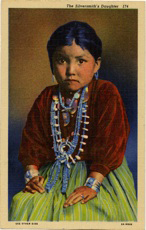Early Peoples: The Navajo
|
The Navajo (Dine) are part of the Athabascan speaking peoples. It is believed that the Athabascans originated in Asia and crossed the Bering Strait during the previous Ice Age. Over thousands of years, the Athabascans traveled south, and reportedly reached the Southwest in about 1400 A.D. This southern group, called Apaches, began to filter into the mountains between Pueblo-held valleys. The Navajo (Dine) are an Apachean group who lived for a time with the Pueblo people, adopting many of their skills and religious beliefs. The arrival of the Spanish in the sixteenth century introduced sheep, goats, and horses to the Navajo. The Navajo were highly adaptive, and they incorporated domestic livestock and agriculture into their subsistence system. They also adopted the horse and, like other tribes who used the animal as a means of transportation, sometimes engaged in slave and food raids on other tribes. This Navajo way of life became very successful, and they spread in extended family units through northern Arizona, New Mexico, and southeastern Utah. Around the year 1700 Navajos began to move into the San Juan River drainage area of Utah in search of pasture for their herds of sheep and goats. While maintaining good relations with the Spanish and Pueblo peoples, Navajos came under intense pressure from raiding Utes from the 1720s through the 1740s, forcing many to retreat from Utah. The Navajo have a unique history and heritage of movement and adaptation that has helped them become the largest tribe in the United States. |


 According to the Navajo, only the Creator knows where the beginning is. The Creator had a thought that created Light in the East. Then the thought went South to create Water, West to create Air, and North to create Pollen from emptiness. This Pollen became Earth. Light, air, water, and earth are contained in everything within nature, and all of the natural world is interconnected and equal. All of these elements mixed together, and the first thing created were the Holy People. These Holy People were given the original laws; then they created the earth and human beings. The Creator, with the help of the Holy People, created the Natural World. They created humans and birds, and all of the Natural World was put in Hozjo, which means balance. The Navajo emerged from the underworld into this world at Xajiinai, a hole in the La Plata Mountains of southwestern Colorado. Centuries ago the Holy People, who were already here, taught the Dine how to live in harmony with Mother Earth, Father Sky, and the other elements: man, animals, plants, and insects. The Holy People taught the Dine important ceremonies to maintain this balance; when the ceremonies cease, the world will cease.
According to the Navajo, only the Creator knows where the beginning is. The Creator had a thought that created Light in the East. Then the thought went South to create Water, West to create Air, and North to create Pollen from emptiness. This Pollen became Earth. Light, air, water, and earth are contained in everything within nature, and all of the natural world is interconnected and equal. All of these elements mixed together, and the first thing created were the Holy People. These Holy People were given the original laws; then they created the earth and human beings. The Creator, with the help of the Holy People, created the Natural World. They created humans and birds, and all of the Natural World was put in Hozjo, which means balance. The Navajo emerged from the underworld into this world at Xajiinai, a hole in the La Plata Mountains of southwestern Colorado. Centuries ago the Holy People, who were already here, taught the Dine how to live in harmony with Mother Earth, Father Sky, and the other elements: man, animals, plants, and insects. The Holy People taught the Dine important ceremonies to maintain this balance; when the ceremonies cease, the world will cease. 

